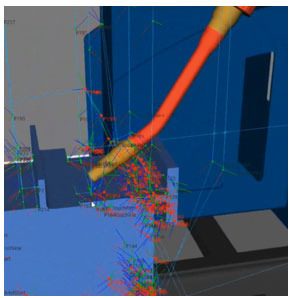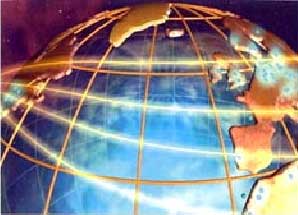With the number of skilled welders available in the workforce dwindling, and the cost of recruiting and retaining them rising, NOW is the time to consider a robotic welder.
Typically, a structural steel fabricator spends a substantial amount of time on labor intensive, repetitive operations such as fitting and welding. Imagine how much simpler things would be if any part of this process could be affordably automated – Not only done faster, but also with consistent quality. It would increase output and free up man-power to perform other tasks.
Robotic welding of beams and columns is the next stage of automation. Imagine tacking all your attachments, placing the beam or column into the automatic rotator – hitting start – walking away to tack the next set of attachments, then coming back a short time later to a completed piece.
In the short time that the Challenger has been on the market, we already have customers with multiple Challengers in operation. No one buys a 2nd machine if the first machine doesn’t exceed their expectations!!!!
The Ocean Challenger structural steel robotic welder is designed and built exclusively for Ocean by AGT, world leaders in robotic technologies. It is specifically designed for fabricators looking to increase production output and reduce labor costs. The compact footprint, fast robotic automation and easy to use software makes the Ocean Challenger welding robot the ideal solution for any size shop striving to be more efficient and cost effective.
The Ocean Challenger Robotic Welder is a fully automated structural steel welding robot that welds attachments to beams and columns that have been tacked in place by the fitter.
| Robot | Fanuc Arc Mate 120i | |
| Welding Equipment | Lincoln Electric R450 Power Source Wire Feeder Welding Torch Collision Detect Torch Cleaning Station (reamer) |
|
| Typical Welding Speed – Fillet Welds (2F) | 20 in/min for 3/16’’ weld – (500mm/min for 5mm weld) 15 in/min for 1/4’’ weld – (380mm/min for 6.5mm weld) 10 in/min for 5/16″ weld – (250mm/min for 8mm weld) |
|
| Beam Size (Effective Welding Zone) |
Section – Minimum 6″ / Maximum 40″ Length – Minimum 4′ / Maximum 50′ |
|
| Gap Tolerances | Maximum 1mm – No Gap Detection | |
| Joint Detection | Laser Touch Sensing | |
| Process and Position | MCAW – Spray and Pulse Transfer – Horizontal (2F) or GMAW – Spray and pulse transfer – Horizontal (2F) |
|
| Wire | MCAW: Hobart Fabcor Edge 0.045″ diameter (1.2mm) or GMAW: Lincoln Electric SuperArc L-59 0.045’’ diameter (1.2mm) |
|
| Wire Classification | MCAW: AWS A5.18, A5.18M: E70C-6M H4 / CSA W48-06: E491C-6MJ-H4 GMAW: AWS A5.18/A5.18M: ER70S-6 / CSA W48-06: ER49S-6 |
|
| Shielding Gas | 85% Argon – 15% CO2 mix | |
| Surface Finish | All parts and beam must be clean & dry with low scale level | |
| Electrical | 480V 3ph 60Hz 50 kVA and 120V 1ph 60Hz 15A | |
| Pneumatic | 100 psi @ 20 CFM Clean Air 0.005MM Dry 99.9%, Unlubricated, 1/2″ NPT |
|
| Ethernet Speed | Upload / Download speed > 10Mbs | |
| Footprint w/Console & Safety Barrier | 68′ x 15′ x 12’H | |
| Weight | 20,000 lbs. | |
The Ocean Challenger Robotic Welder is designed specifically for fabricators and general job shops that need to do structural steel welding and faces issues with labor shortage, need for cost reduction or production growth. Consider the following questions and determine if this machine fits your needs:
If you answered YES to any of the questions above you are a prime candidate for the outstanding Ocean Challenger compact robotic welder, built exclusively for us by AGT, an industry-leader in CNC Robotics.
Here are some of the more commonly asked questions
Every fabricator operates his Challenger differently but this is a simple overview of the operator’s processes:
In some shops the same Challenger operator is responsible for tacking the parts on the beams to be welded, and for doing any finish welding on attachments that were not welded due to potential collision or to inaccessible conditions.
In our experience an operator with good welding knowledge and reasonable computer skills is more than adequate.
The Ocean Challenger Robotic Welder is a fully automated welding robot that welds attachments to beams and columns that have been tacked in place by the fitter. The way the Challenger works is as follows:
Programming the Ocean Challenger welding robot to weld your steel fabrication project is nothing short of Magic!
However, in order for the Challenger to do its magic, you will need to be detailing your project in SDS/2, Tekla Structures, Advanced Steel or any other 3D detailing program that supports IFC file transfer *.
Note that while it is possible to program the Challenger Robot manually, this is not practical. You want to be able to export the files to the machine and have the robot automatically perform its duties of scanning, verifying and welding all attachments to the member without ANY manual programming.
When you are ready to start welding your project, you begin by exporting the building model to Cortex*, via a Plugin installed in your detailing program, and the software will analyze the entire building model, review all assemblies, and generate a report that shows multiple attributes, including

Cortex also generates the complete assembly simulation for each member that includes

All the operator then has to do is select the part to be welded, load it onto the trestles or optional rotators, select the part-program to be run, hit cycle-start, and the Challenger then runs through the entire process, unattended. The operator only has to return to rotate the part at the end of its welding pass, or remove the part at the end of the cycle when using rotators
Note that the software is capable of detecting any weld-data embedded in the model, but often the detailer does not embed any weld data.
When deciding how to perform welds, the Challenger has 3 modes
Hybrid can be used to have you detailer only embed unusual welds, such as stitch welds. Then when the Hybrid model is selected it will use the AWS global weld recipe for all the welds where it doesn’t find embedded data, and use the embedded data for the unusual welds.
* Cortex is AGT’s proprietary software that analyzes the detailing model. Unlike CNC Drill Lines, Angle Lines, and Plate lines, Cortex will not work with DSTV files (.nc) or individual CAD files. Cortex always examines the entire project model in order to analyze the assemblies, so it is important to have a working version of the detailing software on site
The Ocean Challenger Robotic Welder is a bundle purchase and currently has no options available.

At Ocean Machinery, we have built our business and reputation on our commitment to customer satisfaction. We know that you will be depending on your Ocean products, and we are committed to keep your machine functional and operational allowing you to be productive.
The Ocean Challenger Robotic Welder is supported by AGT’s team of dedicated factory trained service technicians, who have the ability to support you with direct troubleshooting over the internet, or via telephone, and when necessary, by servicing the machine onsite.
Our office hours are 8am to 5pm Eastern Time. We welcome your technical support calls at any time during our business hours. Call Ocean Machinery Technical Service at (800) 286-3624
“No need to have any expertise in robotic programming, a few clicks, and it is all done…Zero programming! It’s so easy to use the Challengers proprietary software, it doesn’t take long and it is all automatic. ”
“The first welding done by the Challenger is exactly what we wanted. The welds came out beautiful the very first time, and it only took 17 minutes to do it; it would have taken a welder 3-4- times that to finish that product manually. It came out exactly how we wanted, we are looking forward to perfecting the process, but the first pass was absolutely phenominal.”